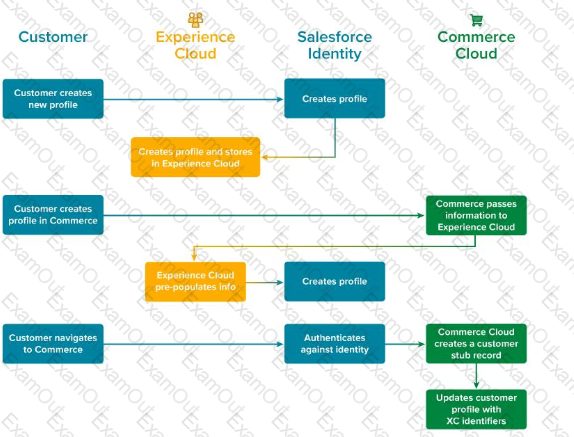A financial company uses an external system for pricing and quotation.
What is the recommended approach to use the pricing and discount rules in the external system within Salesforce during the loan application process?
A B2C Commerce merchant has multiple live sites across different brands and geographies all supported by Service Cloud and Marketing Cloud. Unfortunately, the merchant is having customer service challenges caused by fragmented views of the customer. Customers occasionally use alternate email addresses, make purchases as guests, and contact customer service anonymously. The Success Manager believes that Customer Data Platform (CDP) could help them solve their problem.
How should a Solution Architect describe the role of CDP in this context7
A multi-brand company uses B2C Commerce, Service Cloud, and Marketing Cloud and is seeking an order management solution. They process 2,000 orders per hour across their brands. The company has one B2C Commerce realm, two Salesforce core orgs, and two Marketing Cloud business units. The company is choosing between these three options for an order management tool:
• Build an order management solution in B2C Commerce using order management APIs
• Purchase Salesforce Order Management
• Build a custom order management solution using their own development team
Which three statements should a Solution Architect use to support using the Salesforce Order Management solution?
Choose 3 answers
A company plans to build a new B2C Commerce storefront for a popular segment of products that generate high-volume sales. Their team is evaluating whether B2C Commerce is the right platform to build this storefront, and they are specifically concerned about how quotas and limits directly impact the efficiency and stability of solutions built on the platform.
Which two considerations should a Solution Architect keep in mind when considering B2C Commerce Governance and Quotas?
Choose 2 answers
A company has a multi-cloud implementation that involves an Experience Cloud portal, Service Cloud for case management, and Marketing Cloud for customer interaction.
The company wants all changes in Salesforce data—including creation, updates, deletion, and undeletion of a record—to be synchronized to its custom-built retail loyalty application in near-real time without significantly impacting the overall system performance.
Which option is the most appropriate integration mechanism for this scenario?
At Universal Containers, each admin and developer use a separate developer pro sandbox. Configuration and code are then migrated to a partial data sandbox for combination and initial testing. Once approved the configuration and code are then migrated to a full copy sandbox for final load and regression testing before going to production.
when should the full copy sandbox be refreshed?
An organization uses B2C Commerce to capture order details but needs to process the order in an ERP system. They want B2C Commerce to send a message to the ERP system with the order details after they have been entered, then wait for the order to be processed, and then receive a reply from the ERP system with the order number and status.
Which integration pattern should a Solution Architect use to meet this requirement?
Refer to the exhibit.

A beauty brand is planning to re-platform their existing website onto B2C Commerce. As part of the re-platform they will create a new social community where beauty insiders can view how-to videos, share tips, and favorite products. As part of the overall solution, the beauty brand is going to implement 82C Commerce, Experience Cloud, and Salesforce Identity.
Each beauty insider can store and update important profile and commerce information like email, phone number, beauty preferences, and saved addresses.
Which application should a Solution Architect recommend to set up the primary profile after reviewing the workflow and attempting to minimize migration of customer profile data?
A company wants to implement an abandoned cart solution for their ecommerce storefront in Marketing Cloud. The use case is when a
customer visits their ecommerce website and adds an item to their shopping cart but does not complete the purchase. After an hour has
passed from abandonment, an email containing the item that was in the shopping cart will be sent to the customer to remind them of their incomplete purchase.
What process should a Solution Architect follow to set up the solution?
A university has several branded schools scattered across different colleges. Each of which has its own finances, business processes, and strategies for engaging students. They would like to introduce a university-wide communications strategy that allows their recruitment team to market to potential students globally while allowing each department to recruit existing students for its own programs. They are looking for art environment strategy across their potential purchases of Salesforce and Marketing Cloud.
What should a Solution Architect recommend to meet their needs?

